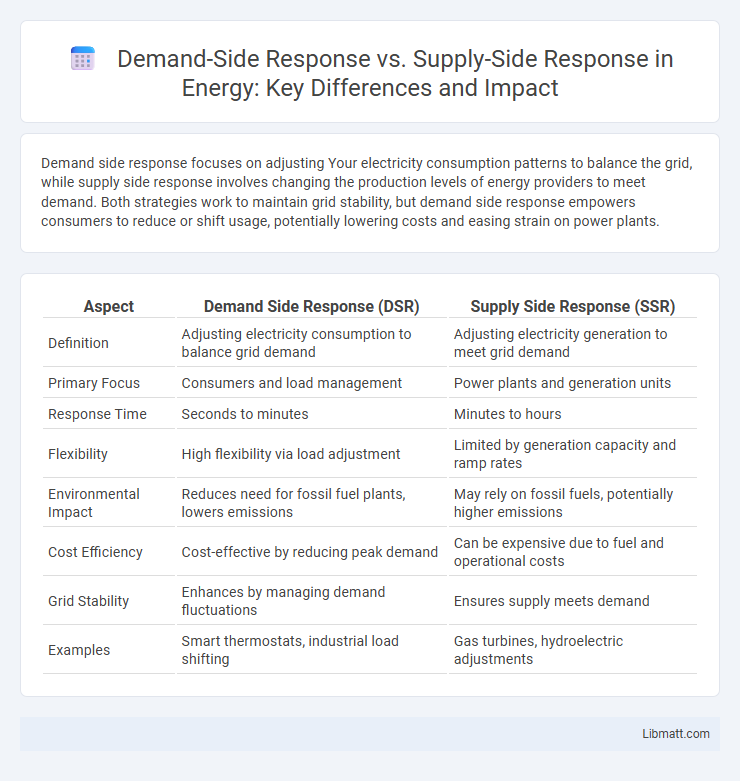Demand side response focuses on adjusting Your electricity consumption patterns to balance the grid, while supply side response involves changing the production levels of energy providers to meet demand. Both strategies work to maintain grid stability, but demand side response empowers consumers to reduce or shift usage, potentially lowering costs and easing strain on power plants.
Table of Comparison
| Aspect | Demand Side Response (DSR) | Supply Side Response (SSR) |
|---|---|---|
| Definition | Adjusting electricity consumption to balance grid demand | Adjusting electricity generation to meet grid demand |
| Primary Focus | Consumers and load management | Power plants and generation units |
| Response Time | Seconds to minutes | Minutes to hours |
| Flexibility | High flexibility via load adjustment | Limited by generation capacity and ramp rates |
| Environmental Impact | Reduces need for fossil fuel plants, lowers emissions | May rely on fossil fuels, potentially higher emissions |
| Cost Efficiency | Cost-effective by reducing peak demand | Can be expensive due to fuel and operational costs |
| Grid Stability | Enhances by managing demand fluctuations | Ensures supply meets demand |
| Examples | Smart thermostats, industrial load shifting | Gas turbines, hydroelectric adjustments |
Understanding Demand Side Response
Demand Side Response (DSR) empowers consumers to adjust their electricity usage during peak demand or grid stress by shifting or reducing consumption, contributing to grid stability and efficiency. Unlike Supply Side Response, which relies on power plants increasing output, DSR leverages flexible demand patterns, reducing the need for costly and polluting peaking power plants. Your active participation in Demand Side Response programs supports a more sustainable energy system and can lead to cost savings on your electricity bills.
Overview of Supply Side Response
Supply Side Response involves adjusting the electricity generation to match demand fluctuations by increasing or decreasing power output from power plants. It includes mechanisms such as ramping up gas turbines, activating standby generators, or utilizing hydroelectric reserves to maintain grid stability. Your energy provider relies on these adjustments to ensure continuous, reliable electricity supply during peak loads or unexpected outages.
Key Differences Between Demand and Supply Side Responses
Demand side response involves adjusting consumer energy usage patterns to match supply availability, enhancing grid flexibility and reducing peak demand. Supply side response focuses on modifying the output of power plants or other generation resources to meet changes in electricity demand, ensuring stability and reliability of the energy system. Key differences include the locus of control--with demand side targeting consumers and supply side targeting producers--and the impact on energy efficiency and grid management strategies.
Benefits of Demand Side Response in Energy Management
Demand Side Response (DSR) enhances energy management by reducing peak demand, lowering energy costs, and improving grid stability through flexible consumption patterns. Unlike Supply Side Response, which relies on increasing generation capacity, DSR leverages your ability to adjust energy use, supporting better integration of renewable sources and minimizing carbon emissions. This approach delivers both economic advantages and environmental sustainability, making energy systems more efficient and resilient.
Advantages of Supply Side Response Strategies
Supply side response strategies enhance grid stability by rapidly adjusting electricity generation to meet demand fluctuations, reducing the need for expensive peaking power plants. These strategies facilitate better integration of renewable energy sources such as wind and solar by providing flexible backup power, which lowers greenhouse gas emissions and operational costs. Moreover, supply side responses improve reliability and resilience of the power system by enabling faster restoration after outages and managing unexpected spikes in demand.
Integration of Demand and Supply Side Responses
Integrating demand side response (DSR) with supply side response enhances grid flexibility by enabling real-time adjustments to electricity consumption and generation. Advanced smart grid technologies and data analytics facilitate seamless coordination between consumer demand patterns and supply fluctuations, optimizing energy efficiency. Your participation in DSR programs supports balancing supply and demand, reducing reliance on costly peaker plants and lowering overall system emissions.
Technological Innovations Driving Demand Side Flexibility
Technological innovations such as smart meters, advanced data analytics, and IoT-enabled devices are revolutionizing demand side response by enhancing real-time monitoring and control of energy consumption. These technologies empower consumers to adjust their electricity usage dynamically, providing grid operators with flexible demand options to balance supply and demand efficiently. Your ability to participate in demand side flexibility not only improves grid stability but also reduces reliance on supply side interventions, lowering overall energy costs and carbon emissions.
Economic Impact of Demand vs. Supply Side Approaches
Demand side response (DSR) reduces electricity consumption during peak periods, lowering operational costs and deferring investment in new generation capacity, which translates into significant economic savings for utilities and consumers. Supply side response involves increasing generation to meet demand, often requiring costly infrastructure upgrades and fuel expenses, leading to higher overall system costs and potential price volatility. Implementing DSR enhances grid flexibility and market efficiency by minimizing the need for expensive peaking plants and reducing wholesale electricity prices.
Policy and Regulatory Frameworks Shaping Responses
Policy and regulatory frameworks for Demand Side Response (DSR) emphasize consumer participation, dynamic pricing, and grid flexibility to incentivize load adjustments. Supply Side Response regulations prioritize generation capacity, grid stability, and emissions standards to ensure reliable energy supply. Integrated policies aim to balance DSR and supply responses, enhancing overall grid resilience and supporting renewable energy integration.
Future Trends and Challenges in Energy Response Management
Demand side response (DSR) is increasingly prioritized for its potential to maximize energy efficiency by adjusting consumption patterns in real time, enabling grid stability amid rising renewable integration. Supply side response (SSR) faces challenges related to the scalability of traditional power generation and the need for rapid ramp-up capabilities to meet fluctuating demand. Future trends highlight the integration of advanced digital technologies like AI and IoT to enhance predictive analytics and automation, while regulatory frameworks must evolve to support flexible market participation and incentivize both DSR and SSR solutions.
Demand side response vs Supply side response Infographic

 libmatt.com
libmatt.com